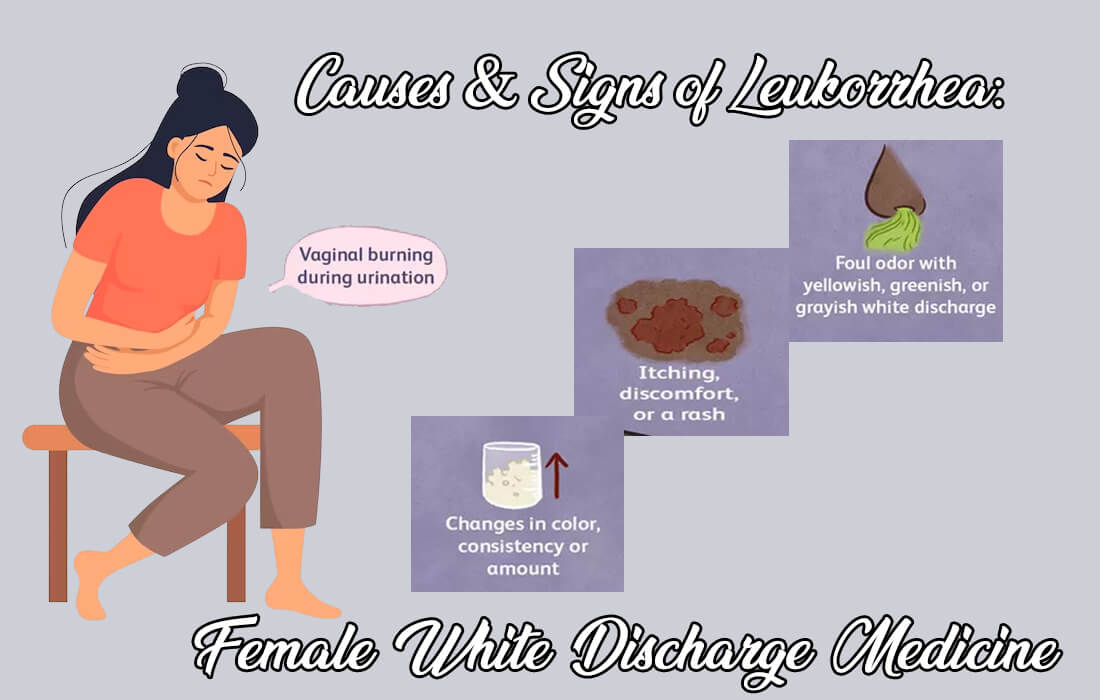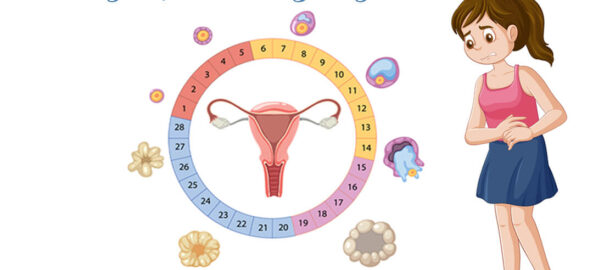
White discharge, also referred to as leukorrhea, is a common occurrence among women of all ages. While it can be a normal part of the female reproductive system, excessive or abnormal white discharge can cause concern. The focus of this article is to examine the causes and associated symptoms and explore the female white discharge medicine that can help manage this condition.
An Introduction: White Discharge
White discharge, also known as leukorrhea, is a natural and common secretion from the female reproductive system. It is a fluid or mucus-like substance that is expelled from the vagina. This discharge can vary in colour, consistency, and amount throughout the menstrual cycle and over a woman’s lifetime. While it serves several important functions, including cleaning the vaginal area, providing lubrication, and protecting against infections, any significant changes in its colour, odour, or consistency can sometimes indicate underlying health issues that may require white discharge best medicine. In general, white discharge is considered a normal and essential part of reproductive health for women of all ages.
To fully understand white discharge, it’s important to explore its characteristics and functions that may affect it.
Characteristics of White Discharge:
- Colour: Normal white discharge is typically clear or milky white. Colour variations may occur, with hormonal changes during the menstrual cycle being one of the contributing factors.
- Consistency: White discharge can exhibit a consistency that spans from thin and watery to thick and sticky. It may become more noticeable during certain times of the menstrual cycle.
- Odour: Normally, white discharge is either odourless or has a mild, musky scent. It should not have a strong or foul odour.
- Amount: The volume of white discharge can vary from person to person and change at different times of the menstrual cycle. It is generally not excessive.
Functions of White Discharge:
White discharge serves several important functions in the female reproductive system:
- Cleaning: One of its primary functions is to clean the vaginal area. It helps remove dead cells, bacteria, and other debris from the vagina, keeping it healthy and free from infections.
- Lubrication: White discharge provides lubrication to the vaginal walls. This lubrication is essential for sexual intercourse as it reduces friction, making intercourse more comfortable and pleasurable.
- Protection: It acts as a protective barrier against potential infections and irritations by maintaining the acidic pH of the vagina. This acidity helps prevent harmful bacteria from proliferating.
- Hormone Regulation: The amount and consistency of vaginal discharge can vary throughout the menstrual cycle due to hormonal changes. Changes in discharge can serve as an indicator of hormonal changes.
Causes and Symptoms of Leukorrhea:
Abnormal white discharge, also known as leukorrhea, can be a concerning issue for women. Understanding its potential causes and associated symptoms is crucial for identifying and addressing any underlying health concerns.
Causes:
- Yeast Infections (Candidiasis): One of the most common causes of abnormal white discharge is a yeast infection. Candida, a type of yeast, can overgrow in the vaginal area, leading to a thick, white, cottage cheese-like discharge. It is common to experience itching, redness, and irritation in the genital area when this condition is present. Yeast infections can be linked to various factors, including the use of antibiotics, hormonal shifts, diabetes, or a weakened immune system.
- Bacterial Vaginosis: Bacterial vaginosis (BV) is another prevalent cause of abnormal discharge. The overgrowth of harmful bacteria causing bacterial vaginosis (BV) is linked to an imbalance in the vaginal flora. The discharge associated with BV is often grey or white and has a strong, fishy odour. The condition frequently brings about itching and burning sensations.
- Sexually Transmitted Infections (STIs): Some sexually transmitted infections, such as chlamydia and gonorrhoea, can cause changes in vaginal discharge. The abnormal discharge associated with STIs may be greenish-yellow, thick, or pus-like. It can also have a foul odour. In addition to discharge, STIs may cause pain during urination, pelvic pain, and discomfort.
- Hormonal Changes: Hormonal fluctuations can affect the characteristics of vaginal discharge. For instance, during pregnancy and breastfeeding, hormonal changes can lead to an increase in white discharge. Menopausal women may also experience changes in discharge due to hormonal shifts.
- Stress and Anxiety: Disruptions in hormonal balance, potentially affecting vaginal discharge, can occur as a result of high-stress levels in the body. Prolonged stress can potentially diminish the immune system’s strength and elevate susceptibility to infections.
- Objects or Irritants: Occasionally, the presence of things in the vaginal area or the use of irritants like scented soaps, douches, or intimate hygiene products can lead to unusual discharge or irritation.
Symptoms:
The symptoms accompanying abnormal white discharge can vary depending on the underlying cause. Here are some common symptoms of abnormal white discharge:
- Itching: Persistent itching in the vaginal area is a common symptom of many causes of abnormal discharge, including yeast infections and BV.
- Burning Sensation: A burning sensation during urination or intercourse can indicate an issue related to abnormal discharge, such as a yeast infection or STI.
- Pain: Pelvic pain or discomfort may be associated with certain infections or conditions causing abnormal discharge.
- Foul Odor: A strong, unpleasant odour emanating from the vaginal area is a concerning sign and is often associated with BV or certain STIs.
- Redness and Swelling: Inflammation and redness around the genital area can be a symptom of an underlying issue that may be causing abnormal discharge.
- Painful Urination: Abnormal discharge can cause discomfort or pain during urination due to infection or irritation.
Therefore, if you experience any of these symptoms, particularly if they persist or worsen, it is essential to seek prompt leukorrhea medicine. Early intervention can help address the issue and prevent complications, ensuring women’s reproductive health and overall well-being.
Conclusion:
Leukorrhea is a natural and necessary vaginal discharge but can be concerning if it is abnormal or accompanied by other symptoms. If you experience abnormal white discharge along with other symptoms, it’s essential to take the necessary female white discharge medicine. While it can vary in colour and consistency, it typically serves important functions such as cleaning, lubrication, protection, and hormone regulation. Proper care and attention to your vaginal health can help ensure your overall well-being.










